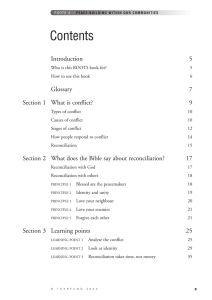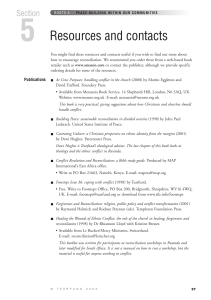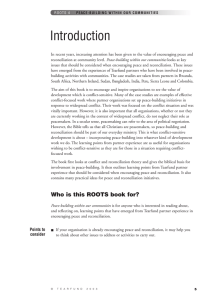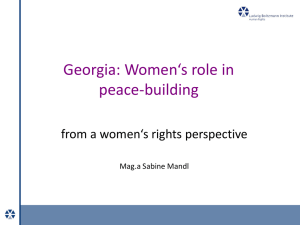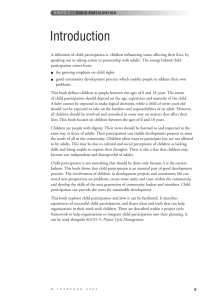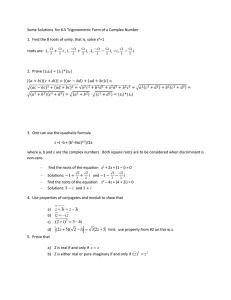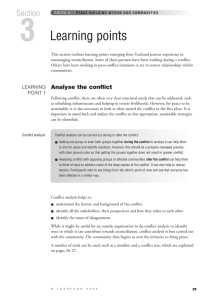1 What is conflict? Section
advertisement
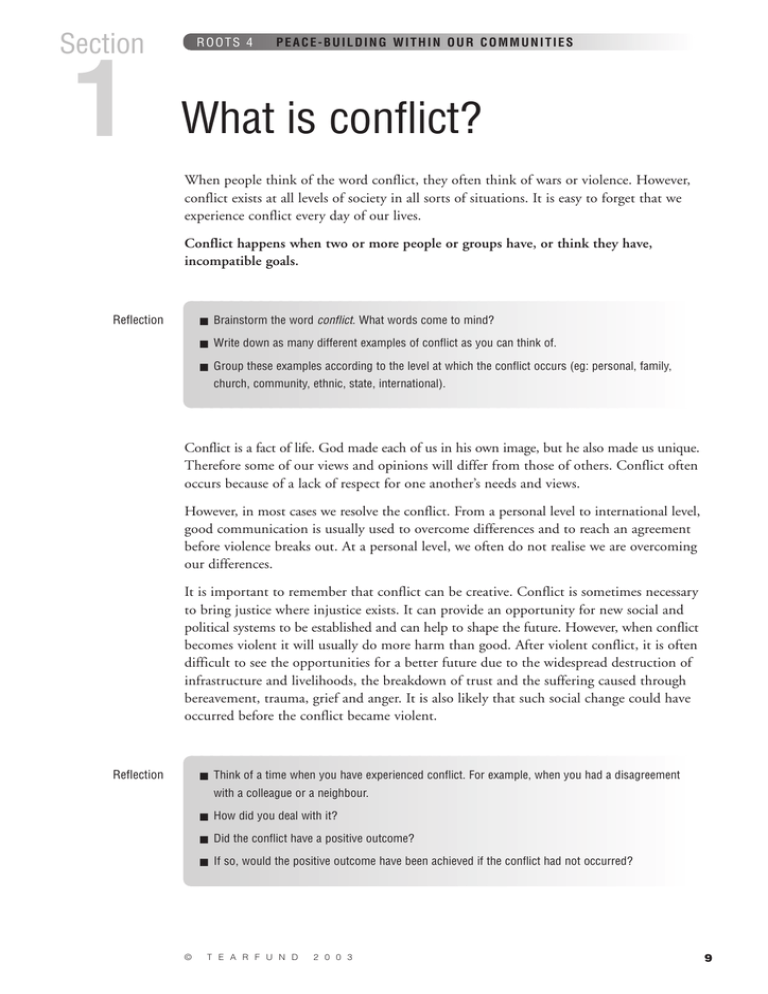
Section 1 ROOTS 4 PEACE-BUILDING WITHIN OUR COMMUNITIES What is conflict? When people think of the word conflict, they often think of wars or violence. However, conflict exists at all levels of society in all sorts of situations. It is easy to forget that we experience conflict every day of our lives. Conflict happens when two or more people or groups have, or think they have, incompatible goals. Reflection ■ Brainstorm the word conflict. What words come to mind? ■ Write down as many different examples of conflict as you can think of. ■ Group these examples according to the level at which the conflict occurs (eg: personal, family, church, community, ethnic, state, international). Conflict is a fact of life. God made each of us in his own image, but he also made us unique. Therefore some of our views and opinions will differ from those of others. Conflict often occurs because of a lack of respect for one another’s needs and views. However, in most cases we resolve the conflict. From a personal level to international level, good communication is usually used to overcome differences and to reach an agreement before violence breaks out. At a personal level, we often do not realise we are overcoming our differences. It is important to remember that conflict can be creative. Conflict is sometimes necessary to bring justice where injustice exists. It can provide an opportunity for new social and political systems to be established and can help to shape the future. However, when conflict becomes violent it will usually do more harm than good. After violent conflict, it is often difficult to see the opportunities for a better future due to the widespread destruction of infrastructure and livelihoods, the breakdown of trust and the suffering caused through bereavement, trauma, grief and anger. It is also likely that such social change could have occurred before the conflict became violent. Reflection ■ Think of a time when you have experienced conflict. For example, when you had a disagreement with a colleague or a neighbour. ■ How did you deal with it? ■ Did the conflict have a positive outcome? ■ If so, would the positive outcome have been achieved if the conflict had not occurred? © T E A R F U N D 2 0 0 3 9 1 What is conflict? ROOTS 4 PEACE-BUILDING WITHIN OUR COMMUNITIES Types of conflict There are many different types of conflict experienced by communities all around the world. We suggest four categories into which most conflicts will fall: Four types of conflict 1 No conflict Any peaceful community is likely to face conflict sometimes, although communities in this category are good at resolving conflict before it develops. 2 Surface conflict This has shallow or no roots. It may be due to misunderstanding of goals, which can be addressed by improved communication and the conscious effort of opposing groups to understand each other’s needs and opinions. 3 Latent conflict be brought out into the open before it can be effectively addressed. 4 Open conflict This conflict is very visible and has deep roots, sometimes over several generations. Both the causes and the effects need to be addressed. Adapted from Working with Conflict page 5 This is conflict below the surface. It might need to Communities experiencing surface or latent conflict are those where the disagreement can quickly turn into open conflict. Open conflict can cause more physical, social, psychological and environmental damage than the other types. It affects people who are not involved in the conflict as well as those who are. Causes of conflict Conflict starts because people do not agree about an issue. Issues of disagreement in recent large-scale conflicts include territory, language, religion, natural resources, ethnicity or race, migration and political power. Sometimes there is more than one issue of disagreement. Conflict at community level could be about any of these issues. 10 T E A R F U N D R O O T S R E S O U R C E S 1 What is conflict? ROOTS 4 PEACE-BUILDING WITHIN OUR COMMUNITIES While a conflict starts because of an issue of disagreement, there are usually background influences that fuel the conflict. The most important influence is power. Others include culture, identity and rights. Power Power is the ability or capacity to do something or to control and influence what others do. It determines who makes decisions and what decisions are made. Power is often shown when two or more people interact. We tend to think of power as belonging to public figures who make decisions, such as politicians and directors of commercial companies. These people often hold a lot of power compared with the people they represent or the people who work for them and buy their products. There are also differences in power in everyday relationships. For example, age, gender, education, literacy and location all influence the amount of power we have or the amount of power that other people will recognise. There are many sources of power. Power is not just military strength. It can include money, networks, information, authority, knowledge, security and access to resources. Everyone has power to some degree. The state of ‘powerlessness’ occurs when people do not think they have power, when they cannot use their power, or when others do not recognise their power. Many people lack the confidence to influence situations which they believe are outside their control. Helping people to gain a sense of self-worth and self-confidence is the first vital step in the process of empowerment. As people gain such confidence, they become more motivated to take action and work together to challenge power imbalances. Conflict is fuelled when the balance of power between different groups changes or is very uneven. Perhaps one group abuses their power, wants more power or fears losing their power. Perhaps another group wants to challenge those in power in order to improve the balance of power. It is important to note that the way in which power is used varies. In a conflict situation, power can be used either to fuel conflict or to help build peace. Two types of power Source: Working with Conflict page 39 It is useful to distinguish between two different types of power: ■ HARD POWER is the ability to command and enforce. Hard power usually represents physical or military power. It is dominant in violent conflicts as opposing groups struggle for victory. ■ SOFT POWER is the ability to bring about co-operation. This type of power is vital for peace-building. Reflection ■ How many different sources of power can you think of? ■ Think about your local area. What types of people or groups have power? ■ What sources of power do you have? ■ Is it possible for someone to possess both hard and soft power? © T E A R F U N D 2 0 0 3 11 1 What is conflict? ROOTS 4 PEACE-BUILDING WITHIN OUR COMMUNITIES Stages of conflict 1 Pre-conflict DIFFERENCES Discussions and differences can be healthy and productive if met with tolerance. TENSIONS Views become fixed and people begin to criticise their opponents and view them as the enemy. Differences between the groups get worse. The groups become more divided. 2 When differences develop into tensions there are unlikely to be any shortcuts to an agreement. Once the crisis point is reached, there are no quick solutions. Confrontation DISPUTES Neither side will admit that they have made mistakes. They become determined. More extreme positions are taken. Threats are made but not carried out. Supporters may engage in demonstrations or other confrontational behaviour. 3 Crisis Peak of conflict with open hostility and/or violence. Communication between sides often stops. HOSTILITIES People become convinced that their views are right. Opponents are mocked, scorned and isolated. Some threats are carried out. VIOLENCE ‘No way back’. ‘They must lose’. Force is used, perhaps physical violence. 4 Outcome Force may run its course until one party ‘wins’, another surrenders, a cease-fire is agreed, or all are exhausted. Outsiders may intervene with force to bring violence to a halt. Adapted from Footsteps 36 pages 8–9 using Working with Conflict page 19 12 T E A R F U N D R O O T S R E S O U R C E S 1 What is conflict? ROOTS 4 PEACE-BUILDING WITHIN OUR COMMUNITIES Opposing groups must open up channels of communication and work upwards to reach full agreement. 9 Agreement Everyone agrees. They may agree to keep different views but always accept the views of others. It may be helpful to have a written and signed agreement for future reference. 8 Finding solutions An approach is found that everyone agrees on, whether this uses the law, customary methods or partnership. Solutions are agreed and acted upon. 7 Mutual understanding People come to understand views of others and respect them. The conflict is described (sometimes mapped) to help find possible solutions. 6 Communication channels opened Both sides agree that a solution is needed. Outsiders may help both sides to communicate. Ways to move forward are established. 5 Post-conflict End of violent confrontation When one side ‘wins’, it may not lead to positive change. It may create new injustices which could result in confrontation (Stage 2) once again. © T E A R F U N D 2 0 0 3 13 1 What is conflict? ROOTS 4 PEACE-BUILDING WITHIN OUR COMMUNITIES How people respond to conflict Giving in LOW Relationships Prioritising relationships and goals HIGH People respond to conflict in different ways, depending on how important they feel it is to maintain a relationship with the opposing group and depending on the amount of power they think they have. This can be represented on a grid: Compromising Forcing Indifference LOW Good and bad points of each response Co-operating Goals HIGH INDIFFERENCE If people feel that both their goals and relationships are not important, they might simply stay out of the conflict. They might feel the conflict is none of their business. On the other hand, they might feel their involvement will make no difference. GIVING IN People give in if they place great importance on their relationships with others and little upon their goals. They want peace at all costs. To be accepted and liked by other people is most important. Conflicts may disappear just because someone stays friendly. But giving in may also mean keeping silent about the real issues and hurts. FORCING People who overpower their opponents have a low regard for other people. They do not place much value on relationships with others. Winning is part of the goal. Some people use force because they are used to being on top or because they do not want to admit that they might be wrong. What they do not see is that by winning, they are forcing others to lose and that they might only stop the conflict for a short time. COMPROMISING People compromise if they know they will not achieve all their goals. They negotiate, bargain and promote relationships without it costing either side too much. They see the need for both sides to gain something. But sometimes the result is that everyone feels the outcome is unsatisfactory or that neither side is committed to the solution. 14 T E A R F U N D R O O T S R E S O U R C E S 1 What is conflict? ROOTS 4 PEACE-BUILDING WITHIN OUR COMMUNITIES CO-OPERATING For these people, relationships and goals are important. They believe that people can find new and imaginative solutions to conflict that lead to both sides winning. When conflicting groups sit down together to discuss their goals, they often realise that their goals have changed. Perhaps they did not look at the long term. Or perhaps they came to see that everyone gained more by working as partners, not opponents. Reconciliation The issues of disagreement that start conflict often hide a deeper problem. Notice that each stage of conflict identified on pages 12 and 13 links to the way people relate to each other. Christians believe that broken relationships are at the root of conflict. A broken relationship with God due to sin leads to broken relationships between people. In SECTION 2 we will look at this in more detail. If broken relationships are at the root of conflict, peace-building must involve reconciliation as well as resolving the issue of disagreement. Why good relationships are important ■ If the issue and the relationship are not addressed, then conflict could more easily break out again in the future. ■ As with other development work, it is important to deal with the underlying cause of the problem as well as the symptoms, if change is to be sustainable. ■ Restoration of relationships can also avoid conflict on other issues in the future, since there is better understanding and experience between opposing groups. Organisations seeking to work towards reconciling communities need to remember that they cannot resolve the conflict or restore relationships themselves. Our role as organisations is to provide an opportunity for opposing sides to communicate with each other in order to resolve the conflict and to reconcile with each other. Tearfund partners have been involved in encouraging peace and reconciliation for a number of years. They have a lot of experience for us to learn from. In SECTION 3, we outline the learning points from Tearfund partners’ experience in providing opportunities for reconciliation. © T E A R F U N D 2 0 0 3 15 1 What is conflict? ROOTS 4 PEACE-BUILDING WITHIN OUR COMMUNITIES The diagram below shows the role that reconciliation plays in transforming conflict. Without concentrating on communication and relationships, it is likely that a vicious circle of conflict could continue. Reconciliation is the key to sustainable peace. Conflict Reconciliation and conflict VICIOUS CYCLE OF CONFLICT Trigger events Conflict ends Hidden hurts Communicate and discuss hurts Resolve issues and build relationships Continual peace-building R E C O N C I L I AT I O N T O B U I L D S U S TA I N A B L E P E A C E 16 T E A R F U N D R O O T S R E S O U R C E S
